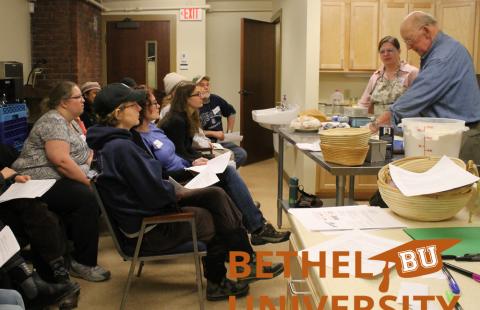What were the specific goals of this creative economy project? Describe the community development challenge or opportunity that your project was designed to address:
Bethel University was created with the intent of addressing several inter-related community challenges:
1) Highlighting the creativity, talents and assets of the community and local residents.
2) Changing the narrative, so that locals & others around the state would start seeing Bethel as a place of opportunity rather than a place with nothing to offer.
3) Attracting visitors to Bethel (from out of town) and giving residents a reason to come downtown and out into the community.
4) Supporting local businesses and organizations and helping them showcase their offerings to the community.
5) Activating underutilized public spaces like the Town Hall, library and school with creative placemaking activities.
6) Generating cultural, arts & learning opportunities in a lightweight, low-budget way.
7) Building community and helping residents to meet their neighbors.
8) Attracting volunteers and building enthusiasm for other community efforts and more substantial revitalization efforts.
If the goals change over time, please describe how:
The goals have not changed substantially. This has been an experimental and emergent project overall, and we've been floored each year by the overwhelming success, support and growth. Some of the benefits of the project were not anticipated, so we've added goals to reflect areas of unexpected community impact.
Those areas include:
1) Attracting participants (professors and students) from out of town;
2) Changing statewide perceptions of Bethel;
3) Using BU as a platform to attract volunteers or complete needed projects.
4) Using BU as a springboard to launch other, larger creative economy or placemaking projects in Bethel.
Who was involved in this project and what did they do? (be sure to include the partners from outside of the creative sector and how local voices were included):
• Bethel Revitalization Initiative - grassroots community group that created and runs BU;
• Town of Bethel - supports the project, has served as fiscal sponsor, and offers free use of Town spaces for classes;
• Bethel Public Library - supports the project, has served as fiscal sponsor, recruits and supports residents without computer access, and offers free use of the Library for classes;
• Bethel Public Schools - supports the project, helps recruit student and faculty participants, and offers free use of the school facilities for classes;
• Christ Episcopal Church - offers free use of the Church buildings for classes;
• BALE (Building a Local Economy) - regional non-profit, helps publicize project;
• Dozens of town businesses - participate by teaching classes or allowing classes to be held in their shops, sponsoring event or providing supplies.
How does this project relate to a larger community development strategy?
There is no town-wide or official community development strategy. With few resources for planning and community development, these activities fall to residents or community groups.
The Bethel Revitalization Initiative has an informal philosophy and strategy that includes the following principles (all of which tie very strategically to BU):
• Create incremental change: start with small, visible projects; celebrate successes and build off them;
• Be a "Do-ocracy": empower people to step up and create the change they want to see in a community. If they have an idea and are willing to help make it happen, clear the way for them to do it and help link it to other efforts;
• Focus on connections: create opportunities for people to meet their neighbors and talk, gather, and bring energy to downtown. Good things happen when people know each other and interact;
• Use a tactical approach: try experimental, low-cost community solutions; evaluate progress and adjust frequently.
What projects or places, if any, inspired your approach to this creative economy project?
As far as we know, BU is the only pop-up university of its kind anywhere in the world and the concept was created entirely by the community. Since starting it, we've learned of similar efforts - usually in larger cities or at actual colleges or universities - but they are typically not free, or are staffed by professionals, or differ in substantial ways. After starting BU, we learned that a nearby town in Vermont (Strafford) has "cabin fever university" - a similar model, but courses are offered for a fee and the project is much smaller.
BU is very much inspired by several larger national movements - the DIY/maker/pop-up movements, and the tactical urbanism movement in planning. Bethel is a town with very few resources, and the BRI was likewise a group with no funding and no official status. We do have a lot of creative, passionate and collaborative members. Our approach has been to find whatever resources we can and create something great, while keeping it nimble and flexible.
